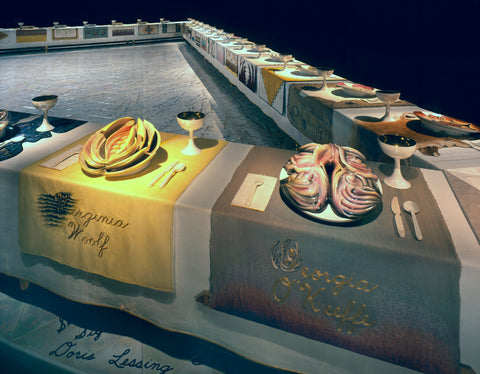
For our first ever "Gals Who Inspire" we chose Judy Chicago, a badass pioneer of Feminist Art of the 1970's as well as a champion of the movement whom lifted as others as she rose to acclaim.
Along with fellow artist Miriam Schapiro, she co-founded several pioneering ventures that elevated women's artistic training and provided much-needed visibility in contemporary art. The first women-only Feminist Art program, at California Institute of Arts and later “Womanhouse”, an installation and performance space. Women in art have come a long way thanks to these programs. Unfortunately, the struggle continues with only 5% of museum collections by women there is still a lot of work to be done. Today, Chicago’s non-profit Through the Flower, continues to provide public education on art as a tool for showcasing women’s achievements and works to eradicate women's under-representation in art and history as a whole.
 Catalog cover for Womanhouse designed by Shiela De Bretville, 1972
Catalog cover for Womanhouse designed by Shiela De Bretville, 1972
As an artist Chicago's her vast and characteristically colorful body of work includes paintings, tapestries, pyrotechnic performance, sculpture, and mixed-media installations. Explicitly female in content she questioned the male-dominated art scene and provided a stage for women's roles and experience throughout history.
 The Dinner Party
The Dinner PartyConsidered the most important work of the Feminist Movement (and Chicago's best-known piece), "The Dinner Party" (1974-1979) is a monumental installation celebrating forgotten female achievements in history. A massive triangular table is set with place settings for 39 mythical and historical women from Sacajawea to Susan B. Anthony and Georgia O'Keeffe. This epic piece has toured 16 venues to an audience of over 15 million. Now calling Brooklyn home, The dinner party permanently resides at the Elizabeth A. Slacker Center for Feminist Art at The Brooklyn Museum
 Smoke Bodies, 1972
Smoke Bodies, 1972We're particularly drawn to Judy Chicago's work with fire, especially her Women and Smoke series. She started working with pyrotechnics in the late 1960s in an effort to feminize the atmosphere at a time when the art scene was unnaturally male dominated. Her Women and Smoke was part of a larger body of work titled Atmospheres, both intended to introduce a feminine impulse into the environment and soften the landscape.
Women and Smoke incorporates pivotal themes of her work, as well as her role as an educator. (Chicago's students were her subjects).
Chicago told The Guardian she "was interested in the whole practice of immolation, forced and chosen... after all, one could say up to that point women's art and women's history had been immolated." At the time of this work, monks in Vietnam were setting fire to themselves to protest the war. Chicago had recently been learning about the Indian practice of sati, where widows are forced to throw themselves into the flames of a funeral fire. These concepts all came together for stunning pyrotechnics, captured by camera.

Immolation IV, 1972 From the Women and Smoke Series

Chicago stopped working with fireworks in 1974, pausing until 2012 for a commission from the Pomona College Art Museum. The reason she stopped in the 70s? She was training to be a pyrotechnician through an apprenticeship and the owner was sexually harassing her. "I simply could not continue" she said.
